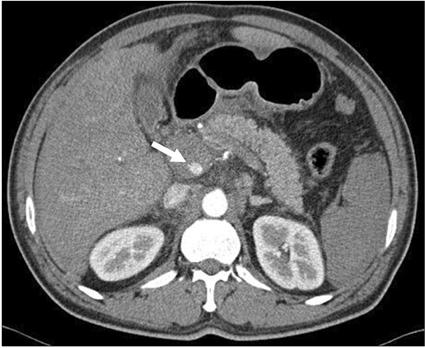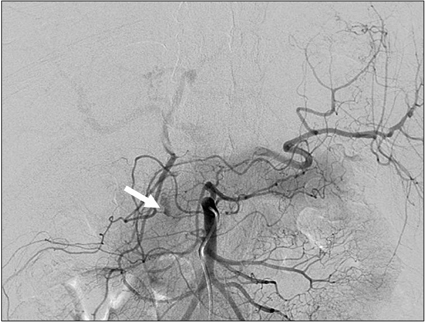J Korean Surg Soc.
2012 Aug;83(2):119-122. 10.4174/jkss.2012.83.2.119.
Damage control surgery in patient with delayed rupture of pseudoaneurysm after blunt abdominal trauma
- Affiliations
-
- 1Division of Trauma Surgery, Department of Surgery, Chonnam National University Medical School, Gwangju, Korea. wkafyddl@hanmail.net
- KMID: 1820099
- DOI: http://doi.org/10.4174/jkss.2012.83.2.119
Abstract
- Delayed rupture of post-traumatic pseudoaneurysms of the visceral arteries, especially the pancreaticoduodenal artery, is uncommon. Here, we describe a 55-year-old man hemorrhaging from a pseudoaneurysm of the inferior pancreaticoduodenal artery (IPDA). Computed tomography of the abdomen showed active bleeding in the IPDA and large amounts of hemoperitoneum and hemoretroperitoneum. Selective mesenteric angiography showed that the pseudoaneurysm arose from the IPDA, and treatment by angioembolization failed because the involved artery was too tortuous to fit with a catheter. Damage control surgery with surgical ligation and pad packing was successfully performed. The patient had an uncomplicated postoperative course and was discharged 19 days after the operation. To our knowledge, this is the first report of ruptured pseudoaneurysm of an IPDA after blunt abdominal trauma from Korea.
MeSH Terms
Figure
Reference
-
1. Marone EM, Mascia D, Kahlberg A, Brioschi C, Tshomba Y, Chiesa R. Is open repair still the gold standard in visceral artery aneurysm management? Ann Vasc Surg. 2011. 25:936–946.2. Pulli R, Dorigo W, Troisi N, Pratesi G, Innocenti AA, Pratesi C. Surgical treatment of visceral artery aneurysms: a 25-year experience. J Vasc Surg. 2008. 48:334–342.3. Teng W, Sarfati MR, Mueller MT, Kraiss LW. A ruptured pancreaticoduodenal artery aneurysm repaired by combined endovascular and open techniques. Ann Vasc Surg. 2006. 20:792–795.4. Pasha SF, Gloviczki P, Stanson AW, Kamath PS. Splanchnic artery aneurysms. Mayo Clin Proc. 2007. 82:472–479.5. Lindner T, Bail H, Heise M, Schmidt SC, Jacob D, Haas NP, et al. Traumatic aneurysm of the superior mesenteric artery associated with a burst-fracture of the second lumbar spine: unforeseen sequelae of a fall from a ladder! Unfallchirurg. 2006. 109:160–164.6. Fitoz S, Atasoy C, Dusunceli E, Yagmurlu A, Erden A, Akyar S. Post-traumatic intrasplenic pseudoaneurysms with delayed rupture: color Doppler sonographic and CT findings. J Clin Ultrasound. 2001. 29:102–104.7. Leong BD, Chuah JA, Kumar VM, Mazri MY, Zainal AA. Successful endovascular treatment of post-traumatic inferior pancreaticoduodenal artery pseudoaneurysm. Singapore Med J. 2008. 49:e300–e302.8. Ding X, Zhu J, Zhu M, Li C, Jian W, Jiang J, et al. Therapeutic management of hemorrhage from visceral artery pseudoaneurysms after pancreatic surgery. J Gastrointest Surg. 2011. 15:1417–1425.9. Schreiber MA. Damage control surgery. Crit Care Clin. 2004. 20:101–118.10. Kim KS, Chang WY, Lee CH, Choi KM, Her KH. Delayed gastrointestinal bleeding from traumatic superior mesenteric artery pseudoaneurysm. J Korean Surg Soc. 2004. 66:523–525.
- Full Text Links
- Actions
-
Cited
- CITED
-
- Close
- Share
- Similar articles
-
- Duodenal Injury after Blunt Abdominal Trauma: Report of Two Cases
- Delayed Splenic Rupture Following Minor Trauma in a Patient with Underlying Liver Cirrhosis
- Delayed Splenic Rupture with a 1-month Latent Period after Minor Trauma: A Case Report
- A Case of Neobladder Rupture Following Blunt Trauma
- Trivial Trauma and Non Pathological Delayed Splenic Rupture: A Case Report



